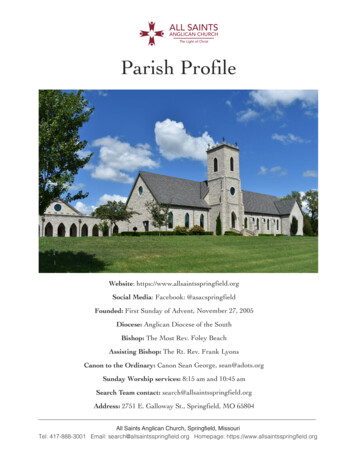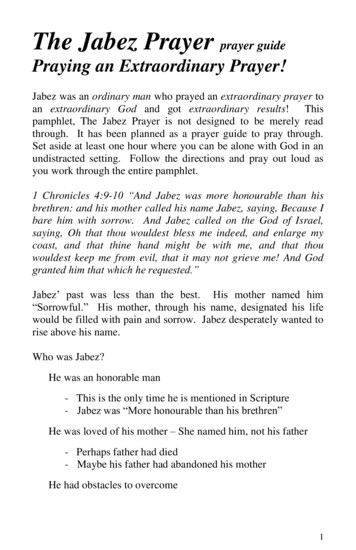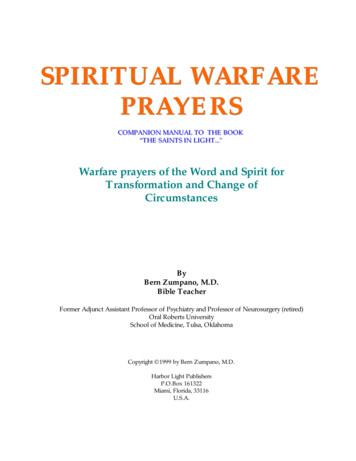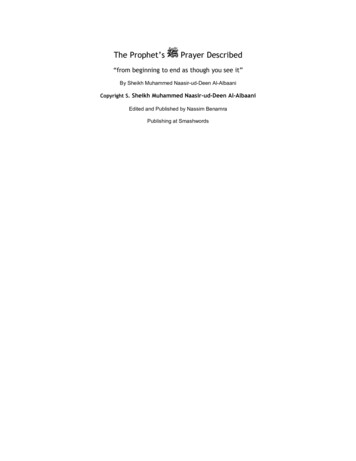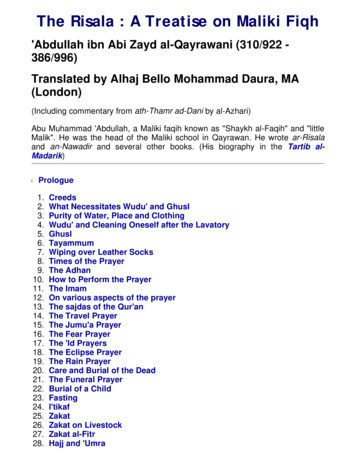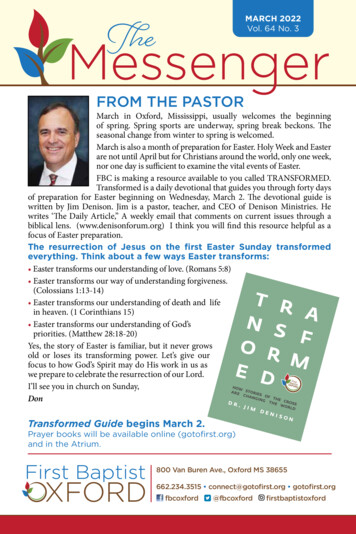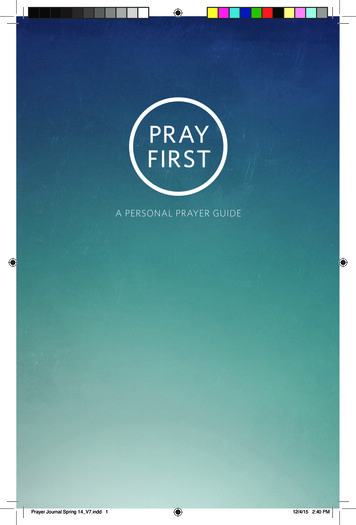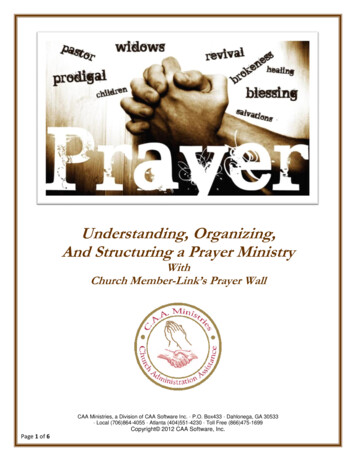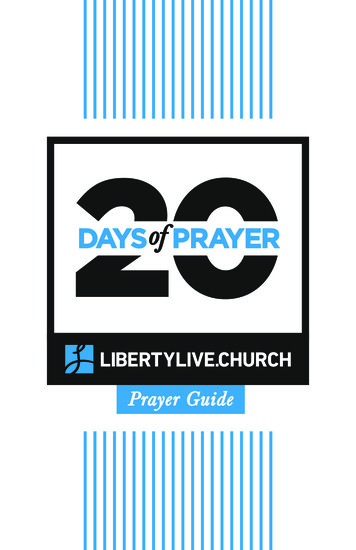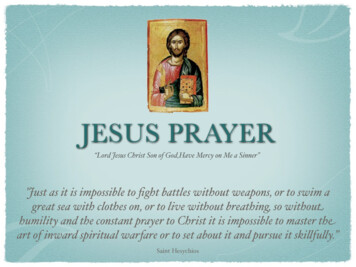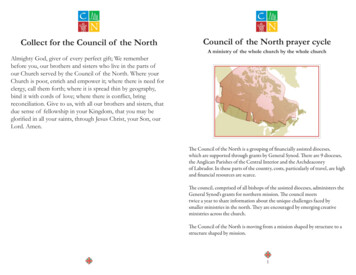
Transcription
Collect for the Council of the NorthCouncil of the North prayer cycleA ministry of the whole church by the whole churchAlmighty God, giver of every perfect gift; We rememberbefore you, our brothers and sisters who live in the parts ofour Church served by the Council of the North. Where yourChurch is poor, enrich and empower it; where there is need forclergy, call them forth; where it is spread thin by geography,bind it with cords of love; where there is conflict, bringreconciliation. Give to us, with all our brothers and sisters, thatdue sense of fellowship in your Kingdom, that you may beglorified in all your saints, through Jesus Christ, your Son, ourLord. Amen.The Council of the North is a grouping of financially assisted dioceses,which are supported through grants by General Synod. There are 9 dioceses,the Anglican Parishes of the Central Interior and the Archdeaconryof Labrador. In these parts of the country, costs, particularly of travel, are highand financial resources are scarce.The council, comprised of all bishops of the assisted dioceses, administers theGeneral Synod’s grants for northern mission. The council meetstwice a year to share information about the unique challenges faced bysmaller ministries in the north. They are encouraged by emerging creativeministries across the church.The Council of the North is moving from a mission shaped by structure to astructure shaped by mission.1
Who we areThe Council of the North is made up of 9 dioceses, 1 regionalgrouping of parishes and 1 archdeaconry. The geographic area of theCouncil covers 85% of Canada and contains 15% of the population.Anglican Parishes ofthe Central InteriorArchdeaconry of LabradorDiocese of the ArcticDiocese of the ArcticDiocese of AthabascaDiocese of BrandonDiocese of CaledoniaIndigenous Spiritual Ministryof MishamikoweeshDiocese of MoosoneeDiocese of QuebecDiocese of SaskatchewanDiocese of SaskatchewanFall meeting of theCouncil of the NorthAugustBishop Barbara AndrewsBishop Geoffrey PeddleBishop David ParsonsSuffragan Bishop Darren McCartneyBishop Fraser LawtonBishop Jim NjegovanBishop William AndersonThe Bishops, General Synod Treasurer, and some diocesan representativesmeet in the fall of each year; usually in late September or early October. Atthis meeting they discuss compensation for the clergy and lay workers ofthe Council dioceses, decide upon grant applications for special programs,and work together in planning for presentations and the future directionof the Council. The Council of the North reports to both the Council ofGeneral Synod and to the General Synod.Bishop Lydia Mamakwa, (Vice-Chair)Archbishop Colin JohnsonBishop Dennis DrainvilleBishop Michael Hawkins(Chair)Diocesan Indigenous Bishop,Adam HalkettDiocese of Yukon Bishop Larry RobertsonPray for Bishop Michael Hawkins, Chair of the Council of theNorth and Bishop Lydia Mamakwa, Vice-Chair and all the members ofthe Council as they work towards a vision of structures shaped by mission.General Synod Treasurer Hanna Goschy215
Message from the chairDiocese of SaskatchewanJulyThe Diocese of Saskatchewan was founded in 1874. It takes up the uppertwo-thirds of the province of Saskatchewan. There are 68 congregationsorganized into 32 parishes. More than half of our parishioners are Creeand speak one of three dialects of that language. The diocese has theJames Settee College, which trains people for lay and ordained ministry,and a youth ministry camp at Camp Okema, Emma Lake.Please pray: For our Bishop, Michael Hawkins, our Diocesan IndigenousBishop, Adam Halkett, for the Synod Executive Committee, DiocesanIndigenous Council and Council of Elders; For our James Settee Collegefor Ministry: For our summer Vacation Bible School programmes; ForStewardship Education and Training; for renewed Lay Leadership.On behalf of those who live and work in Council of the North I wantto thank you for the ongoing and generous support we receive from theAnglican Church of Canada and congregations like yours.The dioceses of the Council of the North, face very unique challenges:vast distances, isolation, the continuing effects of poverty, and the legacyof the residential school system. All of these contribute to an increasedlevel of pastoral needs.Within these dioceses, almost 50% of clergy are non-stipendiary, and thehigh cost of transportation in the north makes frequent travel within eachdiocese cost-prohibitive. Providing ministry in the north also requiresculturally-sensitive leaders trained and equipped for mission.Missioning to Canada’s north, a priority since the earliest days of theAnglican Church, makes the modern day work of the Council a ministryof the whole church, by the whole church.The scriptures say “We, who are many, are one body in Christ andindividually members one of another” (Romans 12:5). Let us seek towalk together as partners on this journey of Christ’s ministry and missionwithin our church.With prayers of thanksgiving for your partnership, I remain,Yours in Christ,The Rt. Rev. Michael HawkinsChair, Council of the North143
Indigenous Spiritual Ministryof MishamikoweeshDiocese of YukonJuneSeptemberOn June 1, 2014, The Indigenous Spiritual Ministry of Mishamikoweeshwas created from the northern portion of the Diocese of Keewatinand will encompass over twenty-five First Nations communities inNorthwestern Ontario and Northern Manitoba. Its structures andprogram are uniquely aboriginal in that it is an expression of Indigenousself-determination within the Anglican Church, committed to upholdingthe tradition, order, and discipline of the Church, expressing thatcommitment in a manner that is consistent with the cultural and spiritualheritage of the Indigenous people of the region.Pray for Bishop Lydia Mamakwa, and for all the leadership of the diocese.Pray also for the Dr. William Winter School of Ministry, the developingdiaconal program, and the increasing ministry collaboration with thedioceses of Brandon and Rupert’s Land.4The Diocese of Yukon was formed in 1891 under the name of Selkirkand was renamed Yukon in 1907. The diocese covers the YukonTerritory and parts of northern British Columbia. It also covers someareas of Alaska when required. There are 15 congregations serving 24communities. There are a total of 30 clergy and licensed lay workers whominister in the diocese. The diocese serves a multicultural society whichincludes 15 First Nations with 10 different language groups.Pray for Bishop Larry Robertson. Pray for the synod office staff, thepeople and clergy of the diocese and for the Diocesan ExecutiveCommittee. Pray that the vision of circle ministry be more deeplyestablished and guide the diocese as they think outside the box as theylook for Ministers of Presence to fill the vacant parishes. Remember alsothe concerted effort to establish youth groups in the diocese.13
Diocese of MoosoneeMayThe Diocese of Moosonee was founded in 1872 and as their website says,“occupies a special place within the mosaic of the Anglican Church ofCanada.” It is the second largest diocese in the country. The diocese issituated in two provinces, northeastern Ontario and northwestern Quebec.More than half of the Anglicans living in the diocese are First Nationspeople; mainly Cree.At the 45th session of the Synod of the Diocese in June 2011, themembers passed a motion directing the Bishop and their “Vision QuestTask Force” to enter into negotiations with the Ecclesiastical Province ofOntario to place the Diocese into “suspension” and ask the Metropolitanto provide administrative and episcopal oversight. This decision wasbrought about by the alarming decrease in the Diocese’s financialresources. A Transition Plan and time-line was adopted by the Diocese inNovember 2011 and through the winter months the Bishop Tom Corstonvisited parishes to explain the process and assure people that local parishministry will remain the same as always once the change is made. Oncethe transition is made on Dec 31 2013(when Bishop Corston retires), thefomer Diocese will be known as the “Moosonee Mission Area” of theEccesliastical Province of Ontario.Archdeaconry of LabradorIn the Diocese of Eastern Newfoundland and LabradorOctoberThe Archdeaconry of Labrador is the largest geographical area of theDiocese of Eastern Newfoundland and Labrador and the most sparselypopulated part of the diocese. There are 6 parishes in the archdeaconryand 8 clergy and lay leaders who pastor and minister there. The Dioceseof Eastern Newfoundland and Labrador was formed in 1976 when thethree diocese formed from the one Diocese of Newfoundland. Withinthe archdeaconry is a multicultural society with 3 main aboriginal groups:Inuit, Innu and Labrador Metis.Pray for Bishop Geoffrey Peddle, for Archdeacon Charlene Taylor, for theclergy and people of the archdeaconry. Remember their ministry to thosewho are very isolated from each other. Pray for the Labrador Planning andStrategy Conference that meets each October and for the annual CampAwesome a Labrador Anglican Youth Gathering which takes place eachLabour Day Weekend.Prayers for the successful transition are desired, as well as for the peopleof the Diocese as they grapple with the change.125
Diocese of CaledoniaNovemberThe Diocese of Caledonia was founded in 1879 and takes up much ofNorthwestern British Columbia. There are 19 parishes in the diocesewhich serves 30 congregations. There are 24 active clergy in the diocesewho serve the people of the diocese. The First Nations cultures of thediocese are rich in diversity; including Haida, Nisgaa, Tsminian, andGitsan.Pray for Bishop William Anderson, the people and clergy of the diocese asthey seek to be faithful in living the Great Commission.Diocese of the ArcticAprilThe Diocese of the Arctic is the largest diocese in the Anglican Church ofCanada. It covers an area of some 4 million square kilometers, one thirdthe landmass of Canada. It stretches from the Yukon border on the westthrough the Northwest Territories, Nunavut Territory, Nunavik (northernQuebec) to the border of Labrador. The Diocese of the Arctic came intobeing in 1933 after almost a hundred years of missionary work in thenorth. The first bishop of the Arctic was Bishop Flemming. There are 31parishes (covering 52 congregations) in the diocese, of these 9 areselfsupporting, and in all but 6 the native language is used as the primarylanguage during worship. There are numerous languages spoken withinthe diocese.Pray for Bishop David Parsons and his wife Rita, Pray for our SuffraganBishop Darren McCartney, Pray for the people and clergy of the diocese.Pray for the rebuilding of the Arthur Turner TrainingSchool in Pangnirtung, which trains locally raised up people forordained ministry in the diocese. Pray for the Cathedral parish ofSt. Jude, Iqaluit and for the Synod office staff in Yellowknife.611
Anglican Parishes of theCentral InteriorDiocese of AthabascaDecemberMarchThe Anglican Parishes of the Central Interior includes the parishes andcommunities that were formerly within the jurisdiction of the Diocese ofCariboo. As a result of the costs of litigation arising from ResidentialSchools, Cariboo wound up its operations in 2001 and asked theMetropolitan of the Province of British Columbia and Yukon to givepastoral oversight. In 2003, the Assembly of the Central Interior askedthe Provincial Synod for permission to elect a Suffragan Bishop to theMetropolitan with responsibility for pastoral care of the clergy andparishes. There are 16 parishes in this regional grouping which take careof 24 congregations. There are 11 full time clergy, 15 part time clergy and62 Lay Ministers of Word and Sacrament who serve the people of theseparishes.Pray for Bishop Barbara Andrews and the clergy and people of theCentral Interior of BC. Pray for the people and clergy as they worktogether at the process of exploring a different way to be church withinthe Anglican Church of Canada.10Founded in 1874 the Diocese of Athabasca covered a large, sparselypopulated area, comprising the northern third of the land mass ofAlberta. This area has moved from one that was initially settled to takeadvantage of access to a lucrative fur trade, to become one of the mosteconomically diverse areas in Canada. The Diocese of Athabasca has hadto adapt from reaching out to small scattered communities, to meetingthe spiritual needs of a population involved in the development of hugeoil and gas reserves, mixed farming and ranching, the lumber industryand communities experiencing tremendous pressure from boom timeexpansion and the challenges of economic downturn. To meet thesechallenges the diocese has 37 congregations served by 16 clergy. Includedin this ministry are four congregations that are in shared ministryrelationships with our fellow followers of Christ in the United Church andELCIC traditions.We give thanks to God for providing for our needs in ministry over thepast year, for increasing the sense of “family” and growth in ministry.Please continue to pray for the provision of finances, discernment instaffing and for the diocesan administration as they seek to continue tomake the Anglican Presence in Northern Alberta a vibrant and living onein these challenging times: The Rt. Rev’d. Fraser Lawton and The VeryRev’d. Dr. Iain Luke, Diocesan Dean.7
Diocese of BrandonJanuaryThe Diocese of Brandon was founded in 1913 and comprises over250,000 sq. kms of the western side of the Province of Manitobaexercising ministry through 54 congregations served by 20 stipendiaryclergy, 13 non-stipendiary and 22 retired clergy. 10 out of the 54Congregations are First Nations (Cree) parishes in the North all ofwhich are served by First Nations Priests who receive either stipends orhonorariums.The diocese is also home to the Henry Budd College for Ministry whichhas provided education opportunities and training for both lay andordained ministries for over 30 years. All of the First Nations Clergy whoserve our communities have taken and/or continue to take courses andworkshops through the College.Pray in thanksgiving for the witness and faith of the parishes of thediocese, the clergy and laity as they seek to make Christ and his redemptivelove known in the communities in which they serve. Pray for Bishop JimNjegovan. Pray in thanksgiving for the ongoing educational ministry ofthe Henry Budd College for Ministry in The Pas and the coordinatorsMarion Jenkins and Paul Sodtke. Pray for the Indigenous parishes ofthe Diocese as they seek how best to become more self-determining andself-supporting. Continue to pray for more vocations to Holy Orders andthe Religious Life within the Diocese and uphold the small BenedictineCommunity of St. James’ and St. John’s in thier witness to our Lord.8Diocese of QuebecFebruaryThe Diocese of Quebec was founded in 1793 and makes up most ofthe geographical province of Quebec. The diocese has 39 parisheswhich serve 105 congregations. The issue of geography and languagecan contribute to much of the feeling of isolation that Anglicans in thediocese have to deal with. Many of the largest parishes in the diocese canbe found on the Lower North Shore, on the Gaspe Pennisula, and on theMagdelan Islands. There is a large aboriginal parish in Kawawachikamach,which is a Naskapi village near the former mining town of Schefferville.The diocese continues to work on how to engage both the francophoneand anglophone populations in a culture which does not take the churchas seriously as it used to.Pray for Bishop Dennis Drainville, his wife Cynthia Patterson and theirdaughter Aurora Patterson-Drainville, for the people and clergy of thediocese as they continue to work on how to provide pastoral care andsupport with decreasing resources; Pray for the work of the Frenchspeaking deanery of the diocese - ministry with French speaking peopleand Pierre Voyer, the Archdeacon of St. Laurent, Fr. Michel Royer, theRural Dean, the Rev. Joanne Brosseau and all the clergy and people of thedeanery.9
Indigenous Council and Council of Elders; For our James Settee College for Ministry: For our summer Vacation Bible School programmes; For Stewardship Education and Training; for renewed Lay Leadership. 3 Message from the chair On behalf of those who live and work in Council of the North I want to thank you for the ongoing and generous support we receive from the Anglican Church of Canada and .
